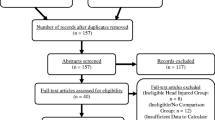Abstract
While the physiologic effects of modern conducted electrical weapons (CEW) have been the subject of numerous studies, their effects on neurocognitive functioning, both short-term and long-term, are less well understood. It is also unclear how these effects compare to other use-of-force options or other arrest-related stressors. We compared the neurocognitive effects of an exposure to a TASER® (TASER International, Inc, Scottsdale, AZ) X26™ CEW to four other use-of-force scenarios during a training exercise using a well-established neurocognitive metric administered repeatedly over 1 h. Overall, we found that there was a decline in neurocognitive performance immediately post-scenario in all groups, but this effect was transient, of questionable clinical significance, and returned to baseline by 1 h post-scenario.





Similar content being viewed by others
References
Kandt v. TASER International, Inc., 2nd Cir. NY; 2012.
U.S. v. Chancellor, S.D. Fla; 2008.
U.S. v. Mack, M.D. La; 2009.
Bryan C, Hernandez AM. Magnitudes of decline on automated neuropsychological assessment metrics subtest sores relative to predeployment baseline performance among service members evaluated for traumatic brain injury in Iraq. J Head Trauma Rehabil. 2012;27(1):45–54.
Thorne DR. Throughput: a simple performance index with desirable characteristics. Behav Res Methods. 2006;38(4):569–73.
Short P, Cernich A, Wilken J, Kane R. Initial construct validation of frequently employed ANAM measures through structural equation modeling. Arch Clin Neuropsychol. 2007;22S:S63–77.
Reich S, Short P, Kane R, Weiner W, Shulman L, Anderson K. Validation of the ANAM test battery in Parkinson’s disease. http://www.dtic.mil/cgi-bin/GetTRDoc?AD=ADA452204. Accessed 25 Feb 2013.
McDiarmid MA, Engelhardt SM, Oliver M, Gucer P, Wilson PD, Kane R, Cernich A, Kaup B, Anderson L, Hoover D, Brown J, Albertini R, Gudi R, Jacoson-Kram D, Squibb KS. Health surveillance of Gulf War I veterans exposed to depleted uranium: updating the cohort. Health Phys. 2007;93(1):60–73.
Harris WC, Hancock PA. Field assessment of cognitive performance under stress. In: Proceedings of HFES 47th annual meeting. 2003;1953–7.
Harris WC, Hancock PA, Harris SC. Information processing changes following extended stress. Mil Psychol. 2005;17(2):115–28.
Harris WC, Hancock PA, Morgan CA, editors. Cognitive change in special forces personnel following stressful survival training. In: Proceedings of HFES 49th annual meeting. 2005;1776–9.
Chelune GJ, Naugle RI, Luders H, Sedlak J, Awad IA. Individual change after epilepsy surgery: practice effects and base-rate information. Neuropsychol. 1993;7:41–52.
Vincent AS, Roebuck-Spencer T, Lopez MS, Twillie DA, Logan BW, Grate SJ, Friedl KE, Schlegel RE, Gilliland K. Effects of military deployment on cognitive functioning. Mil Med. 2012;177(3):248–55.
Criscione J, Boggess M. An independent assessment of the physiological and cognitive effects from the X26 TASER device in volunteer human subjects, Contract W911QY-08-C-0023 (U.S. Marine Corps Joint Non-Lethal Weapons Program) Final Report. Texas A&M University; 2009.
Martinelli R, Staton J. The forensic force series: psychophysiological responses to TASER-ECD influence. Law Enforc Exec Forum. 2010;10(4):101–13.
Crews W, Barth J, Brelsford T, Francis J, McArdle P. Neuropsychological dysfunction in severe accidental electrical shock: two case reports. Appl Neuropsychol. 1997;4(4):208–19.
Salisbury v. Itasca County, 8th Cir. Minn; 2010.
Graham v. Connor, 490 U.S. 386, 296; 1989.
Bryan v. MacPherson, 9th Cir. Cal; 2010.
Ho J, Dawes D, Nelson R, Lundin E, Ryan F, Overton K, Zeiders A, Miner J. Acidosis and catecholamine evaluation following simulated law enforcement use of force encounters. Acad Emerg Med. 2010;17(7):e60–8.
Author information
Authors and Affiliations
Corresponding author
Additional information
TASER International, Inc. provided funding and material support for this study. Dr. Ho is the medical director for TASER. Dr. Dawes is a consultant to TASER. Mr. Brave is the national litigation counsel for TASER. Drs. Ho and Dawes and Mr. Brave own shares of stock in the company. The University of Oklahoma holds the exclusive contract for the development of ANAM.
Rights and permissions
About this article
Cite this article
Dawes, D.M., Ho, J.D., Vincent, A.S. et al. The neurocognitive effects of simulated use-of-force scenarios. Forensic Sci Med Pathol 10, 9–17 (2014). https://doi.org/10.1007/s12024-013-9510-y
Accepted:
Published:
Issue Date:
DOI: https://doi.org/10.1007/s12024-013-9510-y




